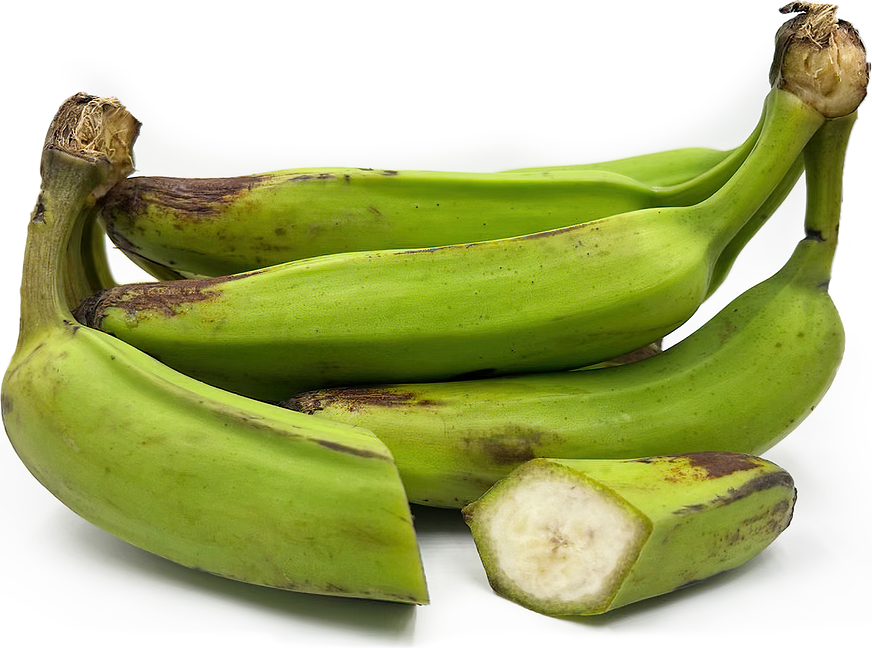


Raw Bananas
Estimated Inventory, lb : 0
Description/Taste
Raw bananas are small to medium in size, ranging from 6 to 30 centimeters long and 2 to 5 centimeters wide. They have an elongated, cylindrical, and slightly curved shape. The peels are thick, smooth, and bright green with a fibrous texture and semi-bitter flavor, and the surface can easily be scratched and marked. The white to cream-colored flesh is dense, firm, and creamy with central tiny, infertile seeds or is seedless, and the flesh runs the entire length of the peel. Raw bananas have a starchy-tart and slightly bitter flavor, as the sugars have not yet developed. When cooked, they will be creamy and taste very similar to potatoes.
Seasons/Availability
Raw bananas are available year-round.
Current Facts
The botanical name for Raw bananas is Musa and they belong to the Musaceae family. Also known as Green bananas, Raw bananas is a general name used to refer to immature, unripe fruit of several banana varieties. Raw bananas have less sugar and a more starchy texture than their ripe counterparts. India is the largest producer of Raw bananas, especially in the southern region where the tropical temperatures are conducive to their growth. Here, these fruits are often called Kaccha Kela. Raw bananas are also popular in the Pacific Islands and the Caribbean, where they may be referred to as Caribbean figs, Guineos, or the potatoes of the Caribbean. They are commonly consumed for a variety of savory culinary applications in both locations.
Nutritional Value
Raw bananas are a source of vitamins B6 and C, nutrients that support metabolism, red blood cell production, immune function, iron absorption, wound healing, and skin, cardiovascular, and brain health. Raw bananas contain fiber and pectin that help with digestion, increase fullness, and improve blood sugar control. This fruit provides the body with potassium and magnesium, encouraging muscle and nerve function, kidney and bone health, energy production, and mood regulation. They possess copper and manganese, protecting cells from oxidative damage and assisting with reproductive health, collagen production, and hormone regulation. Raw bananas also contain resistant starches that promote the growth of probiotic bacteria in the digestive tract.
Applications
Raw bananas are best suited for baking, boiling, frying, steaming, stir-frying, and mashing. They can be sun-dried, left in their peel and used in curries and stir-fries, cooked in boiling water for a smooth texture, or used to make dips and chips. In India, Raw bananas are dried and ground into a flour that has a mild, nutty taste and can be used as a replacement for wheat flour. They are also popularly used in kacche kele ki asharfi, which is Raw banana with capsicum, and in kachori, kebabs, pakore, or poriyals in Southern India. In Kerala, Raw bananas are cooked with yams in coconut milk and are flavored with mustard seeds and curry leaves to make a soup-like dish called Kalan curry. In Bengal, a traditional dish called kanchakalar khosha bata utilizes cooked raw banana peels in a chutney-like dish. Raw bananas pair well with meats such as fish, chicken, pork, and beef, Indian spices such as garam masala, cumin, mustard, and turmeric, zucchini, bell pepper, ginger, garlic, onion, yams, and potatoes. They will keep for a couple of weeks when stored in a cool, dry place.
Ethnic/Cultural Info
In India, Raw bananas are seen as cooling astringents and are used in traditional Ayurvedic medicine. Ayurveda, the science of self-healing, believes that Raw bananas can help in the overall health of the body and may regulate the passing of stool during diarrhea. They are also believed to be an anti-inflammatory when cooked with turmeric and cow’s milk, and can help reduce symptoms associated with ulcers. Raw bananas are used in place of potatoes by those of the Jain religion of India, who are forbidden to eat root vegetables.
Geography/History
Bananas are believed to have been cultivated since at least 8000 BCE and are native to the Indo-Malaysia region, extending up to Northern Australia. Today, bananas are produced in tropical and subtropical areas in Asia, the Americas, Africa, and Australia. While there are wild species of bananas, the domesticated version that’s commonly consumed today is selectively bred and cultivated commercially or in gardens. They are often sold green, giving consumers the option to enjoy them unripe or let them ripen to yellow. Raw bananas can be found at local markets, grocery stores, and banana plantations throughout the world.
Recipe Ideas
Recipes that include Raw Bananas. One
Podcast















